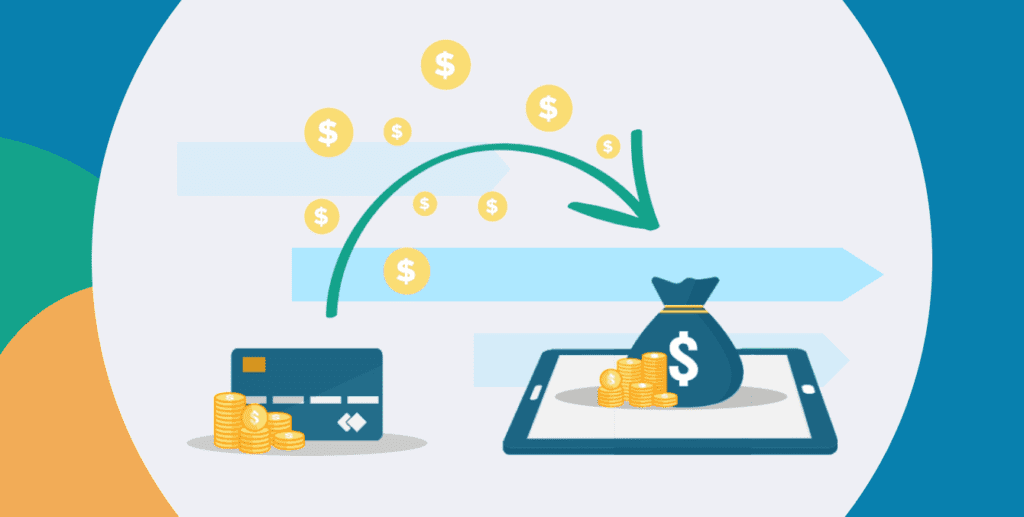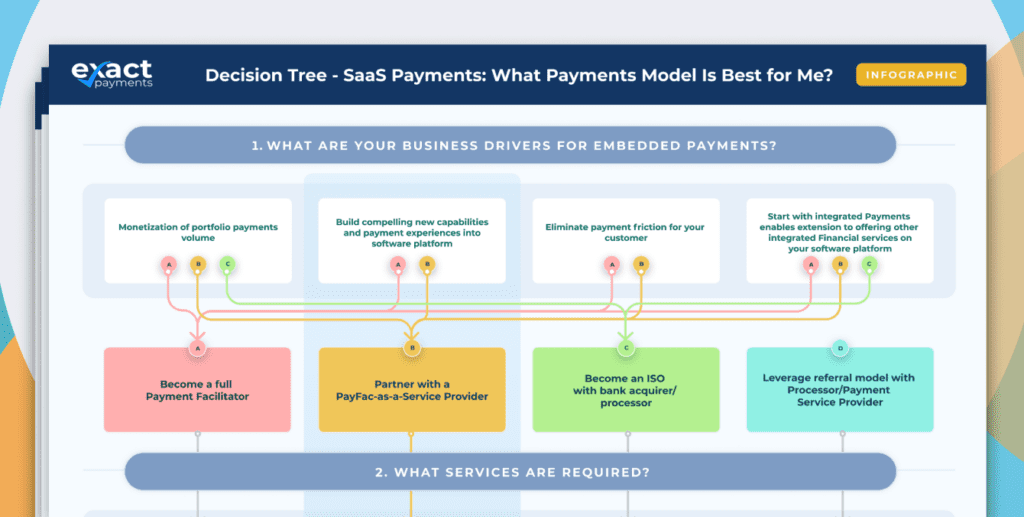What Are Embedded Payments?

Embedded Payments Explained
What are embedded payments? A good embedded payments definition is payment processing functionality that is integrated within a software platform, enabling the platform’s clients to accept payments. Software developers utilize a payments API to embed the many behind-the-scenes processes that happen during and after a transaction is complete — from authentication and funding to settlement and compliance. Embedded payments are unified with a software platform’s existing user interface so that the buyer does not know there is a payment company behind the software brand. And the best part? SaaS businesses reap the reward of a revenue stream from the payment processing fees collected on their platform. In fact, SaaS businesses can increase revenue per customer by 2-5x!
Embedded payments are everywhere — though due to their inherent nature, you may not have noticed them. These payments are meant to integrate with the existing software, offering a consistent and frictionless user experience. From ride-sharing apps to accounting software, embedded payment processing is becoming increasingly seamless. Read on for more embedded payments explained
Real-Life Embedded Payments Examples: How Embedded Payments Work
To illustrate what we mean by embedded payment processing, imagine you develop real estate management software for property managers. Now envision two scenarios: scenario A, in which payments are not embedded, and scenario B, where payments are a part of the software.
Scenario A
In scenario A, your property management customers process payments through a third-party processor. In order to accept payments, property managers direct homeowners to pay their annual dues using an external link to the processor’s payment form. While simple and convenient, this solution diverts the homeowners to another site, which can be jarring, discontinuous, and even a little suspect. Though security is (hopefully?!) covered under the third-party payments provider, with no transaction data, you have very little insight into your customers’ financials. This also adds a layer of complexity for your customer since they may be exporting transaction data from the payment provider to import and evaluate in another tool, resulting in a manual process prone to error. Plus, you leave money on the table, handing over revenue to whichever payment processor the property manager chooses.
Scenario B
In scenario B, payments are embedded in your software using the API of your integrated payments partner. As property managers utilize your software for their daily business needs, they take advantage of the built-in invoicing functionality, which alerts homeowners to pay their dues via an alert on their HOA portal. Homeowners also receive an email with a link to the property manager’s branded payment form. Sensitive payment information is collected using drop-in fields from the provider’s API, which tokenizes and sends the data to your payment provider’s gateway. This way, payment data never touches your servers, and you ensure the security of your customers’ card data.
Additionally, since all other transaction data is available within your solution via the payment provider’s API, you gain valuable insight into your customer’s finances while providing them with a convenient all-in-one tool unique to their vertical. In turn, this enforces dependence on your solution, increasing customer retention and generating an additional revenue stream for your business.
Benefits of Embedded Payments
Revenue Growth
Embedded payments allow software companies to generate a new revenue stream from the payments processed on their platform. Every time a transaction is processed, the SaaS earns a portion of the processing fee. For a SaaS that offers payment capabilities to its clients, this can result in a significant impact on the bottom line.
Improved Customer Experience
With embedded payments in applications, payments are integrated into the software platform and the user flow is streamlined and friction is reduced. This is opposed to a third-party redirect or a branded payment page with the processor’s logo. These types of interruptions distract users and can even damage trust.
Increased Retention
As clients come to depend on payments to run their business, they are less likely to switch SaaS providers. As the value to customers goes up, the software platform becomes sticky, increasing customer retention.
Enhanced Data Insight
Infusing payment data within your platform can make existing platform data more valuable. For example, in the case of accounting software, embedded B2B payments data can close the loop on manual processes with automated accounts receivable reconciliation — reducing manual labor.
Advanced Technology
Using a payments API allows software developers to tap into a payments infrastructure that is constantly evolving to support the latest technology. Instead of trying to keep up with the payments industry on their own, the SaaS benefits from consistent improvements like digital wallets and network tokenization.
Reduced Infrastructure Costs
Likewise, an API integration also reduces infrastructure costs. A payments API allows communication between the SaaS and the payment gateway with no need to build a new payments infrastructure. The embedded payments provider has everything a software company could need to offer payment acceptance at a cost significantly less than building a payments infrastructure from scratch.
Embedded Payment Models
Embedded payments can be implemented using a variety of payment models. The most common models are the Independent Sales Organization (ISO) referral model, payment facilitator (payfac) model, and PayFac-as-a-Service model.
ISO Referral Model
The ISO referral is the most basic embedded payments model. In this setup, part of the payment process is integrated with the software; however, the SaaS business refers merchant clients to the ISO. An ISO acts as a middleman between the SaaS and acquiring member banks. The ISO offers the SaaS business a small referral fee for their leads. The ISO then handles onboarding the merchant and any customer support they may need in relation to payments.
Payment Facilitator (PayFac)
A PayFac is an entity that facilitates payments for its merchant clients. It builds and supports the payment infrastructure used to process payments. PayFacs own the onboarding process and maintain direct relationships with their clients. These organizations also keep 100% of the revenue as a result of owning payment processes like processing, funding, settlement, data security, and compliance. The PayFac does not have to split revenue with a third party; however, they do have to pay for ongoing maintenance costs to keep payments up and running.
PayFac-as-a-Service
A PayFac-as-a-Service solution allows SaaS businesses to offer payment acceptance without having to invest in payment infrastructure. Instead, a PFaaS provider builds out the infrastructure. The PFaaS provider and the SaaS divide the profits earned from payment processing.
Embedded vs. integrated payments
As we’ve explained in this article, embedded payments represent a paradigm shift in the world of financial services. This approach seamlessly integrates financial functionalities within your SaaS platform, transforming it into a holistic ecosystem. With embedded payment solutions, your SaaS business can offer various financial services, from payment processing to lending and beyond.
Integrated payments, on the other hand, focus primarily on integrating payment processing capabilities within your SaaS application. While not as extensive as embedded banking services and embedded finance solutions, this approach remains essential for SaaS businesses seeking to streamline transactions and accelerate revenue.
The decision between implementing embedded versus integrated payments also hinges on your business objectives and target audience. While embedded payments offer a broader scope, integrated payments provide a quick and efficient solution.
Consider your long-term strategy, customer demands, and the potential for exploring new revenue streams. Some SaaS businesses even opt for a hybrid approach to monetize payments themselves, combining both embedded financial solutions and integrated payment solutions to maximize their revenue potential.
The Takeaway
Embedded payment processing represents an incredible opportunity for SaaS businesses to serve their clients better while driving an additional income stream. Creating a frictionless payment process within your tool increases customer satisfaction, retention rates, and sales.
We hope this blog on “What Are Embedded Payments” was helpful. Ready to start accepting payments? Check out our embedded payments solutions.



